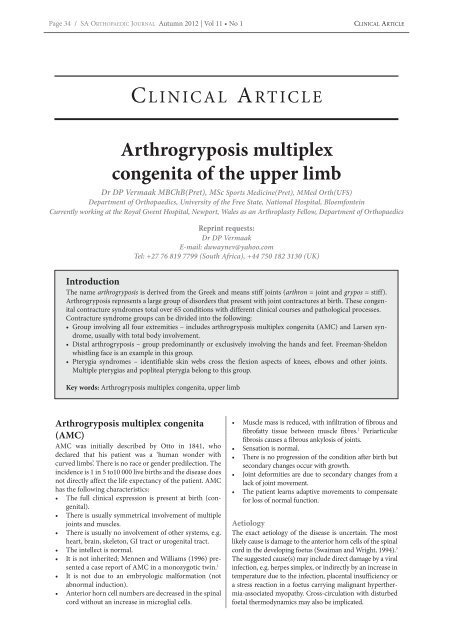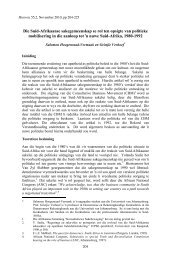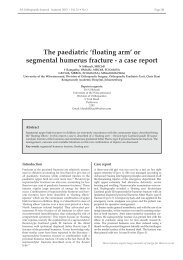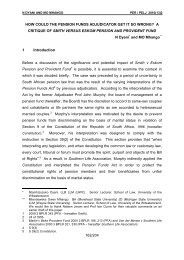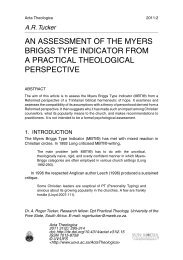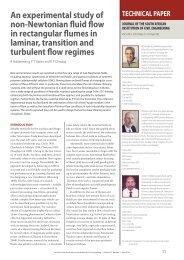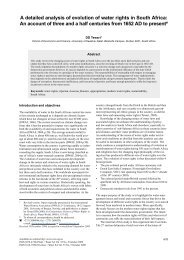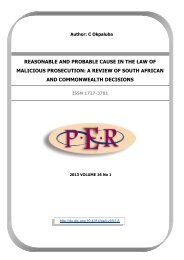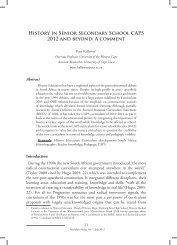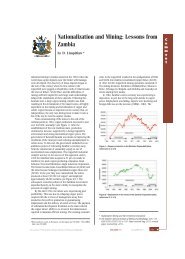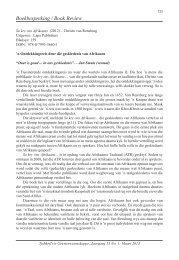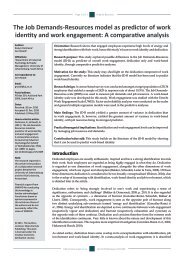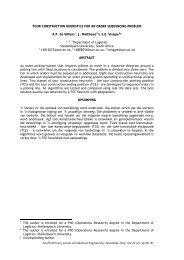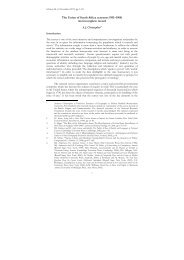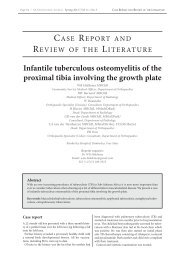Arthrogryposis multiplex congenita of the upper limb
Arthrogryposis multiplex congenita of the upper limb
Arthrogryposis multiplex congenita of the upper limb
Create successful ePaper yourself
Turn your PDF publications into a flip-book with our unique Google optimized e-Paper software.
Page 34 / SA OrThOPAeDIC JOurnAL Autumn 2012 | Vol 11 • no 1<br />
CLInICAL ArTICLe<br />
C L I n I C A L A rT I C L e<br />
<strong>Arthrogryposis</strong> <strong>multiplex</strong><br />
<strong>congenita</strong> <strong>of</strong> <strong>the</strong> <strong>upper</strong> <strong>limb</strong><br />
Dr DP Vermaak MBChB(Pret), MSc Sports Medicine(Pret), MMed Orth(UFS)<br />
Department <strong>of</strong> Orthopaedics, University <strong>of</strong> <strong>the</strong> Free State, National Hospital, Bloemfontein<br />
Currently working at <strong>the</strong> Royal Gwent Hospital, Newport, Wales as an Arthroplasty Fellow, Department <strong>of</strong> Orthopaedics<br />
Reprint requests:<br />
Dr DP Vermaak<br />
E-mail: duwaynev@yahoo.com<br />
Tel: +27 76 819 7799 (South Africa), +44 750 182 3130 (UK)<br />
Introduction<br />
The name arthrogryposis is derived from <strong>the</strong> Greek and means stiff joints (arthron = joint and grypos = stiff).<br />
<strong>Arthrogryposis</strong> represents a large group <strong>of</strong> disorders that present with joint contractures at birth. These <strong>congenita</strong>l<br />
contracture syndromes total over 65 conditions with different clinical courses and pathological processes.<br />
Contracture syndrome groups can be divided into <strong>the</strong> following:<br />
• Group involving all four extremities – includes arthrogryposis <strong>multiplex</strong> <strong>congenita</strong> (AMC) and Larsen syndrome,<br />
usually with total body involvement.<br />
• Distal arthrogryposis – group predominantly or exclusively involving <strong>the</strong> hands and feet. Freeman-Sheldon<br />
whistling face is an example in this group.<br />
• Pterygia syndromes – identifiable skin webs cross <strong>the</strong> flexion aspects <strong>of</strong> knees, elbows and o<strong>the</strong>r joints.<br />
Multiple pterygias and popliteal pterygia belong to this group.<br />
Key words: <strong>Arthrogryposis</strong> <strong>multiplex</strong> <strong>congenita</strong>, <strong>upper</strong> <strong>limb</strong><br />
<strong>Arthrogryposis</strong> <strong>multiplex</strong> <strong>congenita</strong><br />
(AMC)<br />
AMC was initially described by Otto in 1841, who<br />
declared that his patient was a ‘human wonder with<br />
curved <strong>limb</strong>s’. There is no race or gender predilection. The<br />
incidence is 1 in 5 to10 000 live births and <strong>the</strong> disease does<br />
not directly affect <strong>the</strong> life expectancy <strong>of</strong> <strong>the</strong> patient. AMC<br />
has <strong>the</strong> following characteristics:<br />
• The full clinical expression is present at birth (<strong>congenita</strong>l).<br />
• There is usually symmetrical involvement <strong>of</strong> multiple<br />
joints and muscles.<br />
• There is usually no involvement <strong>of</strong> o<strong>the</strong>r systems, e.g.<br />
heart, brain, skeleton, GI tract or urogenital tract.<br />
• The intellect is normal.<br />
• It is not inherited; Mennen and Williams (1996) presented<br />
a case report <strong>of</strong> AMC in a monozygotic twin. 1<br />
• It is not due to an embryologic malformation (not<br />
abnormal induction).<br />
• Anterior horn cell numbers are decreased in <strong>the</strong> spinal<br />
cord without an increase in microglial cells.<br />
• Muscle mass is reduced, with infiltration <strong>of</strong> fibrous and<br />
fibr<strong>of</strong>atty tissue between muscle fibres. 2 Periarticular<br />
fibrosis causes a fibrous ankylosis <strong>of</strong> joints.<br />
• Sensation is normal.<br />
• There is no progression <strong>of</strong> <strong>the</strong> condition after birth but<br />
secondary changes occur with growth.<br />
• Joint deformities are due to secondary changes from a<br />
lack <strong>of</strong> joint movement.<br />
• The patient learns adaptive movements to compensate<br />
for loss <strong>of</strong> normal function.<br />
Aetiology<br />
The exact aetiology <strong>of</strong> <strong>the</strong> disease is uncertain. The most<br />
likely cause is damage to <strong>the</strong> anterior horn cells <strong>of</strong> <strong>the</strong> spinal<br />
cord in <strong>the</strong> developing foetus (Swaiman and Wright, 1994). 3<br />
The suggested cause(s) may include direct damage by a viral<br />
infection, e.g. herpes simplex, or indirectly by an increase in<br />
temperature due to <strong>the</strong> infection, placental insufficiency or<br />
a stress reaction in a foetus carrying malignant hyper<strong>the</strong>rmia-associated<br />
myopathy. Cross-circulation with disturbed<br />
foetal <strong>the</strong>rmodynamics may also be implicated.
CLINICAL ARTICLE SA ORTHOPAEDIC JOURNAL Autumn 2012 | Vol 11 • No 1 / Page 35<br />
Classification<br />
This classification system is based on <strong>the</strong> amount <strong>of</strong> anterior<br />
horn cell damage and <strong>the</strong> resultant degree <strong>of</strong> stiffness<br />
due to muscle under-development. Mennen (1993) 3 suggested<br />
that pre- and post-operative clinical evaluation<br />
could divide patients into <strong>the</strong> following groups:<br />
• Type I: ‘Loose’ type has little involvement <strong>of</strong> anterior<br />
horn cells and good functional prognosis. The <strong>limb</strong>s<br />
appear normal and <strong>the</strong>se patients will have little difficulty<br />
in walking. Their deformities are correctable<br />
pre-operatively and spinal muscles are not involved.<br />
Secondary surgical procedures are rarely indicated.<br />
• Type II: ‘Stiff ’ type has very little pre-operative joint<br />
movement. The patients’ spinal muscles are involved<br />
which affects <strong>the</strong>ir ability to sit and stand. They present<br />
with severe club foot deformities, and hip and<br />
knee subluxation or dislocation. There are very few if<br />
any muscle fibres found intra-operatively. Joint capsules<br />
are thick and contracted, <strong>of</strong>ten with intra-articular<br />
adhesions and secondary joint deformity.<br />
A new classification system has been proposed by<br />
Mennen (2004) 4 that takes <strong>the</strong> function and age <strong>of</strong> <strong>the</strong><br />
patient into account. Passive movement (baby), active<br />
movement (young child) and function (older child and<br />
adult) are assessed; function is calculated from <strong>the</strong> ranges<br />
<strong>of</strong> movement (active and passive) and <strong>the</strong> ability to execute<br />
activities <strong>of</strong> daily living with a specific joint. These<br />
values are expressed as a percentage <strong>of</strong> normal and plotted<br />
on a disc-o-gram, <strong>the</strong>reby creating an image <strong>of</strong> total body<br />
function. Any change in function from <strong>the</strong>rapy or surgery<br />
can be plotted on <strong>the</strong> same disc-o-gram and will <strong>the</strong>reby<br />
change <strong>the</strong> shape and size <strong>of</strong> <strong>the</strong> ‘image <strong>of</strong> function’.<br />
The patients are classified into five types by adding up<br />
<strong>the</strong> values <strong>of</strong> joint movement or functional ability. These<br />
groups are fur<strong>the</strong>r divided up into three subsections<br />
depending on <strong>the</strong> pattern <strong>of</strong> <strong>limb</strong> involvement:<br />
0–2 I Rigid<br />
A) Both <strong>upper</strong> <strong>limb</strong> (UL) and lower <strong>limb</strong> (LL)<br />
involvement (i.e. UL and LL involvement)<br />
B) Minimal or no LL involvement (i.e. UL<br />
involvement)<br />
C) Minimal or no UL involvement (i.e. LL<br />
involvement)<br />
2–4 II Minimal mobility<br />
A) Both UL and LL involvement (i.e. UL and LL<br />
involvement)<br />
B) Minimal or no LL involvement (i.e. UL<br />
involvement)<br />
C) Minimal or no UL involvement (i.e. LL<br />
involvement)<br />
A new classification system has been proposed by<br />
Mennen (2004) that takes <strong>the</strong> function and age <strong>of</strong> <strong>the</strong><br />
patient into account<br />
4–6 III Moderate mobility<br />
A) Both UL and LL involvement (i.e. UL and LL<br />
involvement)<br />
B) Minimal or no LL involvement (i.e. UL<br />
involvement)<br />
C) Minimal or no UL involvement (i.e. LL<br />
involvement)<br />
6–8 IV Near normal mobility<br />
A) Both UL and LL involvement (i.e. UL and LL<br />
involvement)<br />
B) Minimal or no LL involvement (i.e. UL<br />
involvement)<br />
C) Minimal or no UL involvement (i.e. LL<br />
involvement)<br />
8–10 V Mobile/normal<br />
A) Both UL and LL involvement (i.e. UL and LL<br />
involvement)<br />
B) Minimal or no LL involvement (i.e. UL<br />
involvement)<br />
C) Minimal or no UL involvement (i.e. LL<br />
involvement)<br />
Clinical features<br />
The <strong>limb</strong>s are stiff in varying degrees and appear tubular<br />
with smooth skin over joints and absence <strong>of</strong> normal skin<br />
folds. Deep dimples may be seen over <strong>the</strong> large joints. The<br />
muscles are reduced in size and feel firmer than normal.<br />
The shoulders are adducted and internally rotated with<br />
weak or absent shoulder girdle muscles. The arms may be<br />
in such severe internal rotation that <strong>the</strong> hands may only<br />
be used in pronation. The elbows are more <strong>of</strong>ten in extension<br />
than flexion, with weak or absent biceps and<br />
brachialis muscles, while <strong>the</strong> triceps is less affected. Wrists<br />
are usually pronated, in severe flexion and ulnar deviation,<br />
lacking wrist extension. The thumbs are adducted<br />
across <strong>the</strong> palms (thumb-in-palm deformity) and <strong>the</strong> fingers<br />
are flexed and rigid. The finger deformities usually<br />
involve rigid flexion at <strong>the</strong> IP joints and neutral to extension<br />
position <strong>of</strong> <strong>the</strong> MP joints. The fingers are <strong>of</strong>ten overlapped<br />
and with slight flexion in a ‘paw’ position.<br />
Patients with AMC are usually pain-free. Complaints<br />
that may be present are inguinal hernias due to weakened<br />
musculature, or feeding problems due to a stiff jaw and<br />
immobile tongue that can lead to respiratory infections<br />
and a failure to thrive. The face is not particularly dysmorphic,<br />
but may demonstrate a small jaw, facial narrowing<br />
and, if <strong>the</strong> ocular muscles are involved, a limited<br />
upward gaze.<br />
Two-thirds <strong>of</strong> patients have equal involvement <strong>of</strong> all four<br />
<strong>limb</strong>s, and in one-third lower <strong>limb</strong> involvement (club feet,<br />
flexion deformity <strong>of</strong> <strong>the</strong> knee and subluxed or dislocated<br />
hips) will predominate. Upper <strong>limb</strong> involvement rarely<br />
predominates. When spinal muscles are involved <strong>the</strong> child<br />
has difficulty with sitting and standing up.
Page 36 / SA ORTHOPAEDIC JOURNAL Autumn 2012 | Vol 11 • No 1<br />
CLINICAL ARTICLE<br />
Up to one-third <strong>of</strong> patients will develop scoliosis. The<br />
joints appear normal on X-ray, and <strong>the</strong> changes are adaptive<br />
and acquired over a period <strong>of</strong> time due to <strong>the</strong> joints’ fixed<br />
position.<br />
The diagnosis <strong>of</strong> AMC is clinical, but it may be suspected<br />
if <strong>the</strong> prenatal ultrasound demonstrates a decrease in foetal<br />
movements, especially in combination with polyhydramnios.<br />
Some contractures seem to become stiffer over time<br />
but no new joints become involved.<br />
AMC patients may develop compensatory movements to<br />
assist activities <strong>of</strong> daily living such as pushing <strong>the</strong> forearm<br />
against a table to bring <strong>the</strong> hand close to <strong>the</strong> mouth to eat, or<br />
if <strong>the</strong> patients are standing <strong>the</strong>y may reach <strong>the</strong>ir face by<br />
swinging <strong>the</strong>ir arms and using lumbar spine lordosis and<br />
gravity to assist <strong>the</strong> movement. These patients may also<br />
assist <strong>the</strong>mselves using a cross-arm technique.<br />
Management<br />
When considering management <strong>of</strong> <strong>the</strong> <strong>upper</strong> <strong>limb</strong> <strong>the</strong><br />
whole arm must be taken into consideration and individual<br />
joints must not be isolated. The ultimate goal <strong>of</strong> surgery<br />
to <strong>the</strong> <strong>upper</strong> <strong>limb</strong> is to improve <strong>the</strong> patient’s self-care<br />
ability, especially eating and hygiene (writing is a bonus).<br />
Conservative management<br />
All <strong>upper</strong> <strong>limb</strong> deformities must be gently manipulated<br />
(muscle and joint stretching) from birth by a qualified<br />
hand <strong>the</strong>rapist with <strong>the</strong> best results achieved if started<br />
before 6 months <strong>of</strong> age. 3 Physio<strong>the</strong>rapy includes passive<br />
manipulation several times a day followed by night-time<br />
splinting <strong>of</strong> <strong>the</strong> position gained. The <strong>the</strong>rapist may fur<strong>the</strong>r<br />
assist <strong>the</strong>se children by teaching <strong>the</strong>m trick movements to<br />
achieve better function. Splinting a patient in a certain<br />
position may allow <strong>the</strong> patient to decide if <strong>the</strong> new position<br />
will be desirable or not before surgery is done.<br />
Deformity correction may be attempted by <strong>the</strong> following<br />
measures:<br />
• Intensive exercise programme – usually only results in<br />
a slight improvement in ROM with <strong>the</strong> chances <strong>of</strong> success<br />
declining with age, and little gain expected after 3<br />
years <strong>of</strong> age. 9<br />
• Serial casting – this is time-consuming with a high<br />
rate <strong>of</strong> recurrence. If done too aggressively it may<br />
cause cartilage necrosis and fur<strong>the</strong>r stiffness. Smith<br />
and Drennan recommended <strong>the</strong> use <strong>of</strong> serial casting<br />
for wrist flexion deformities, 10 but did show that <strong>the</strong><br />
classical form <strong>of</strong> arthrogryposis with rigid wrist deformities<br />
was resistant to serial casting. Some feel that<br />
serial casting may lessen <strong>the</strong> extent <strong>of</strong> surgery, even<br />
though <strong>the</strong> deformity is not completely corrected. 6<br />
Repeat casting is unlikely to be successful if recurrence<br />
<strong>of</strong> <strong>the</strong> deformity occurs.<br />
If no fur<strong>the</strong>r correction can be achieved by conservative<br />
or surgical means <strong>the</strong>n <strong>the</strong> patient will benefit from modification<br />
<strong>of</strong> mechanical aids. The following are some<br />
examples:<br />
• Chair and tables – <strong>the</strong>se will <strong>of</strong>ten need adjustment for<br />
feeding and playing.<br />
• Eating and drinking – it may be necessary to fix <strong>the</strong><br />
plate to <strong>the</strong> table and adjust <strong>the</strong> handles <strong>of</strong> eating utensils.<br />
• Dressing – Velcro can replace buttons, and zips can be<br />
fitted with large ring handles. Dressing may fur<strong>the</strong>r be<br />
assisted by using shoes without laces and sticks to<br />
assist with <strong>the</strong> activity <strong>of</strong> getting dressed.<br />
• Toilet needs – self-cleaning toilets are available, but are<br />
expensive and will only be available in <strong>the</strong> home environment.<br />
The height <strong>of</strong> toilet seats may also need to be<br />
adjusted at home to accommodate <strong>the</strong> patient.<br />
Showers may need to be fitted with seats and liquid<br />
soap dispensers.<br />
Surgical management<br />
Surgery is <strong>of</strong>fered after 6 months if <strong>the</strong>re is a failure to<br />
progress with conservative measures. Some <strong>of</strong> <strong>the</strong> principles<br />
<strong>of</strong> surgery (Mennen) are <strong>the</strong> following:<br />
• Early surgery. The ideal time for surgery is between<br />
3–6 months <strong>of</strong> age. 5 Early surgery is easier, e.g. carpal<br />
bones can be removed with a scalpel. A younger child<br />
recovers faster, with less scarring and has <strong>the</strong> ability to<br />
remodel joint surfaces. They are also more adaptable,<br />
reducing <strong>the</strong> need for intensive physio<strong>the</strong>rapy after <strong>the</strong><br />
procedure. In very young children <strong>the</strong> remnants <strong>of</strong> <strong>the</strong><br />
carpal bones left behind develop ossification centres,<br />
which will result in functional carpal bones. 5 The surgery<br />
becomes more difficult later, i.e. after 1 year, as<br />
contractures become more fixed and joint congruity<br />
changes, limiting joint movement. Joint adhesions<br />
increase and <strong>the</strong> skin becomes less pliable adding to<br />
<strong>the</strong> abnormal joint movement.<br />
• One-stage procedures. One-stage procedures give better<br />
results than staged procedures 5 and may include<br />
surgery to bones, joints and s<strong>of</strong>t tissue rebalancing.<br />
However, as <strong>the</strong> child grows, smaller procedures may<br />
be needed to maintain optimum function.<br />
• Osteotomies. Correction <strong>of</strong> deformity by osteotomy is<br />
<strong>of</strong> limited value in young children as remodelling will<br />
cause recurrence <strong>of</strong> <strong>the</strong> deformity within 1–2 yrs.<br />
Management <strong>of</strong> <strong>the</strong> hand and<br />
wrist in AMC<br />
The wrist is almost always affected with a flexion deformity<br />
<strong>of</strong> up to 90° and ulnar deviation. It is widely agreed<br />
that correction <strong>of</strong> <strong>the</strong> hand and wrist deformity will<br />
improve <strong>the</strong> overall function <strong>of</strong> <strong>the</strong> <strong>upper</strong> <strong>limb</strong>.<br />
The ultimate goal <strong>of</strong> surgery to <strong>the</strong> <strong>upper</strong> <strong>limb</strong><br />
is to improve <strong>the</strong> patient’s self-care ability, especially eating<br />
and hygiene (writing is a bonus)
CLINICAL ARTICLE SA ORTHOPAEDIC JOURNAL Autumn 2012 | Vol 11 • No 1 / Page 37<br />
Carpectomy<br />
This procedure was met with mixed results according to<br />
earlier literature, 12 but when performed early (3–6<br />
months) and in combination with s<strong>of</strong>t tissue balancing as<br />
part <strong>of</strong> a one-stage procedure it has shown promising outcomes.<br />
3,5 When <strong>the</strong> carpectomy is performed before ossification<br />
<strong>of</strong> <strong>the</strong> carpal bones it has <strong>the</strong> following advantages:<br />
• The unossified carpal bones allow <strong>the</strong> surgeon to<br />
sculpt a wedge-shaped removal <strong>of</strong> cartilaginous bones<br />
with a scalpel.<br />
• The exact anatomy <strong>of</strong> <strong>the</strong> carpal bones can be ignored<br />
and <strong>the</strong> surgeon only needs to focus on removing a<br />
clearly defined trapezoid wedge from <strong>the</strong> carpal<br />
bones.<br />
In milder forms <strong>of</strong> <strong>the</strong> disease <strong>the</strong> trapezoid should be<br />
removed from <strong>the</strong> mid-section <strong>of</strong> <strong>the</strong> carpus, leaving <strong>the</strong><br />
radio-carpal joint intact. The carpus is not only shortened<br />
by <strong>the</strong> trapezoid wedge, but <strong>the</strong> following is <strong>of</strong> importance:<br />
• The volar portion <strong>of</strong> <strong>the</strong> trapezoid wedge relaxes <strong>the</strong><br />
volar capsule and <strong>the</strong> o<strong>the</strong>r s<strong>of</strong>t tissues, e.g. neurovascular<br />
structures. When <strong>the</strong> flexor tendons are relaxed,<br />
it allows <strong>the</strong> fingers to assume a more functional position.<br />
• The dorsal portion <strong>of</strong> <strong>the</strong> trapezoid wedge helps correct<br />
<strong>the</strong> wrist flexion deformity. The size <strong>of</strong> <strong>the</strong> wedge<br />
is determined by <strong>the</strong> need to achieve 40° <strong>of</strong> dorsiflexion;<br />
<strong>the</strong> wrist is <strong>the</strong>n fixed with K-wires. In severe<br />
cases almost all <strong>the</strong> carpal bones may need to be<br />
included in <strong>the</strong> wedge and rarely <strong>the</strong> base <strong>of</strong> <strong>the</strong> second<br />
to fifth metacarpals.<br />
S<strong>of</strong>t tissue balancing<br />
The wrist’s dorsal capsule is incised transversely before<br />
<strong>the</strong> carpectomy. These flaps are <strong>the</strong>n sutured tightly<br />
overlapping each o<strong>the</strong>r. The wrist flexor’s flexor carpi<br />
ulnaris (FCU), flexor carpi radialis (FCR) and palmaris<br />
longus are transferred to <strong>the</strong> dorsal side to augment <strong>the</strong><br />
dorsal pull on <strong>the</strong> metacarpals. The FCU and/or FCR<br />
are sutured to <strong>the</strong> extensor carpi radialis brevis (ECRB)<br />
or to <strong>the</strong> distal capsular flap. Z-leng<strong>the</strong>ning <strong>of</strong> <strong>the</strong>se<br />
flexors may be necessary in order to achieve this.<br />
Wrist extensors may be poorly developed, but extensor<br />
carpi ulnaris (ECU) can be centralised to compensate<br />
for weak wrist extension.<br />
Mennen recommends <strong>the</strong> sequence <strong>of</strong> carpectomy followed<br />
by internal pinning, <strong>the</strong>n performing <strong>the</strong> capsular<br />
suturing and finally doing <strong>the</strong> flexor tendon transfer to<br />
protect <strong>the</strong> volar neurovascular structures, which may<br />
be tensioned unnecessarily if ano<strong>the</strong>r sequence is followed.<br />
3<br />
Older patients or patients with recurrence <strong>of</strong> <strong>the</strong>ir<br />
deformity may benefit from wrist arthrodesis as a salvage<br />
procedure to achieve a more functional position <strong>of</strong><br />
<strong>the</strong>ir wrist.<br />
Thumb adduction<br />
The thumb-in-palm deformity is <strong>the</strong> result <strong>of</strong> a combined<br />
thumb adduction and first MCP joint flexion contractures<br />
and prevents <strong>the</strong> hand from grasping normally. If <strong>the</strong><br />
thumb fails to correct with passive and dynamic first web<br />
space manipulation, <strong>the</strong>n a thumb adduction release is<br />
indicated which may need to be combined with an opponensplasty.<br />
3 The flexor pollicis longus musculotendinous<br />
complex is also released to achieve adequate correction.<br />
Williams recommended a combined first web space<br />
release with transfer <strong>of</strong> a superficial flexor tendon (usually<br />
<strong>the</strong> ring finger’s superficial tendon) dorsally to replace<br />
<strong>the</strong> typically absent thumb extensors and abductor.<br />
Drummond et al. suggested a Z-plasty for <strong>the</strong> first web<br />
space and release <strong>of</strong> adductor pollicis with or without MPJ<br />
fusion. 11<br />
Finger stiffness<br />
Improvement in ROM is seen with gentle manipulation. It<br />
is also noted that if <strong>the</strong> wrist is placed in 40° <strong>of</strong> dorsiflexion<br />
before 12 months <strong>of</strong> age <strong>the</strong> finger and metacarpophalangeal<br />
joints are more mobile and normal skin<br />
folds over <strong>the</strong> joints can develop. 3 Occasionally contractures<br />
may need to be released and skin grafted. Williams<br />
described an intrinsic release for patients with MP joint<br />
flexion contracture and extension <strong>of</strong> <strong>the</strong> IP joints. If <strong>the</strong> IP<br />
joints have an extension contracture <strong>the</strong>n a dorsal release<br />
can be done with a flexor tendon shortening. 11<br />
After correction <strong>of</strong> wrist and hand deformities <strong>the</strong> patient<br />
is usually splinted in a functional position until skeletal<br />
maturity.<br />
Management <strong>of</strong> <strong>the</strong> elbow in AMC<br />
Elbow flexion is particularly important in <strong>the</strong>se patients in<br />
order to achieve independent function in feeding and care<br />
<strong>of</strong> <strong>the</strong> face and hair. Extension <strong>of</strong> <strong>the</strong> elbow is required for<br />
toilet and transfers if <strong>the</strong> lower <strong>limb</strong>s are severely affected.<br />
Ideally one arm (dominant arm) should be able to function<br />
in flexion to perform feeding activities, and one arm<br />
should be able to function in extension for hygiene purposes.<br />
Goals <strong>of</strong> treatment are to achieve at least 90° flexion<br />
from a fixed extended position. If both elbows are equally<br />
involved, surgery to increase flexion should only be done<br />
on <strong>the</strong> one side.<br />
Elbow flexorplasty<br />
Arthrolysis and capsular release are indicated if passive<br />
manipulation has not achieved more than 90° <strong>of</strong> elbow flexion<br />
by 6 months’ <strong>of</strong> age. The triceps can be leng<strong>the</strong>ned by a<br />
Z- or V-Y leng<strong>the</strong>ning procedure if necessary. If active<br />
elbow flexion is lacking <strong>the</strong> surgeon will need to do a flexorplasty<br />
at <strong>the</strong> same time as <strong>the</strong> joint release procedure, bearing<br />
in mind that passive elbow flexion to 90° is a prerequisite.<br />
Various options are available for an elbow flexorplasty:
Page 38 / SA ORTHOPAEDIC JOURNAL Autumn 2012 | Vol 11 • No 1<br />
CLINICAL ARTICLE<br />
• Steindler flexor origin transfer – The flexor origin is<br />
released from <strong>the</strong> medial epicondyle and transposed<br />
proximally and anteriorly on <strong>the</strong> humerus. It is seldom<br />
recommended in AMC as <strong>the</strong> flexor muscles are shortened,<br />
fibrotic and have poor excursion and may fur<strong>the</strong>r<br />
tighten wrist and finger flexors in a patient with existing<br />
wrist and finger flexor contractures. The flexor group <strong>of</strong><br />
muscles is also too weak to achieve active elbow flexion.<br />
• Clark pectoralis major muscle transfer: Here 2½ inches<br />
<strong>of</strong> <strong>the</strong> sternal head <strong>of</strong> pectoralis major is detached, tubed<br />
and attached to <strong>the</strong> biceps tendon at <strong>the</strong> elbow.<br />
Schottstaedt, Larsen and Bost modified <strong>the</strong> technique by<br />
detaching <strong>the</strong> entire sternal head <strong>of</strong> pectoralis major.<br />
The muscle is completely mobilised on its neurovascular<br />
pedicle, <strong>the</strong> muscle insertion reattached to <strong>the</strong> acromion<br />
process and <strong>the</strong> sternal origin to <strong>the</strong> biceps tendon or <strong>the</strong><br />
radius with rectus fascia. The muscle is seldom functional<br />
but occasionally it may be powerful enough for<br />
elbow flexion. 3<br />
• Latissimus dorsi muscle transfer (Hovnanian): The origin<br />
<strong>of</strong> latissimus dorsi is detached and <strong>the</strong> muscle belly<br />
mobilised on <strong>the</strong> long thoracodorsal nerve, passing it<br />
subcutaneously down <strong>the</strong> anterior aspect <strong>of</strong> <strong>the</strong> arm and<br />
suturing it to <strong>the</strong> biceps tendon. Like pectoralis major<br />
this muscle is <strong>of</strong>ten non-functional in AMC but if it is<br />
available it is <strong>the</strong> best option for elbow flexion. 3<br />
• Triceps tendon transfer: This is a viable option for tendon<br />
transfer to achieve elbow flexion if <strong>the</strong> triceps<br />
muscle strength is at least a grade 4/5. The technique<br />
<strong>of</strong> Carroll and Hill involves detaching <strong>the</strong> triceps<br />
aponeurosis and periosteum from <strong>the</strong> olecranon and<br />
proximal ulna, which is passed subcutaneously<br />
around <strong>the</strong> lateral aspect <strong>of</strong> <strong>the</strong> elbow and attached to<br />
<strong>the</strong> proximal radius or biceps tendon. The disadvantage<br />
<strong>of</strong> <strong>the</strong> procedure is that if an undesirable flexion<br />
contracture <strong>of</strong> <strong>the</strong> elbow is created, it will be nearly<br />
impossible to correct. If a flexed elbow <strong>of</strong> more than<br />
90° occurs in one arm and <strong>the</strong> o<strong>the</strong>r arm is in extension,<br />
<strong>the</strong> patient loses <strong>the</strong> ability to transfer objects<br />
from one hand to <strong>the</strong> o<strong>the</strong>r, losing <strong>the</strong> bimanual function.<br />
A flexed elbow has <strong>the</strong> functional advantage <strong>of</strong><br />
being able to reach <strong>the</strong> mouth and <strong>the</strong> perineum and<br />
performing most o<strong>the</strong>r activities <strong>of</strong> daily living. A gutter<br />
crutch may also be used if <strong>the</strong> patient has difficulty<br />
with walking and stability.<br />
• Van Heest et al. demonstrated that elbow capsulotomy<br />
and triceps leng<strong>the</strong>ning alone without tendon transfer<br />
improved passive elbow flexion and <strong>the</strong> arc <strong>of</strong> elbow<br />
motion to enable hand-to-mouth activities. 7 Twentynine<br />
elbows were operated in 23 children and an average<br />
<strong>of</strong> 33° <strong>of</strong> passive motion was achieved, changing <strong>the</strong> arc<br />
<strong>of</strong> motion to a more flexed position. The authors felt that<br />
<strong>the</strong> risk <strong>of</strong> tendon transfer after capsulotomy may outweigh<br />
<strong>the</strong> benefits if <strong>the</strong> patient could achieve functional<br />
independence by o<strong>the</strong>r means such as compensatory<br />
movements.<br />
In <strong>the</strong> older patient an elbow arthrodesis (Kelikian) or an<br />
anterior closing wedge osteotomy <strong>of</strong> <strong>the</strong> distal humerus<br />
may be used to place <strong>the</strong> patient’s limited arc <strong>of</strong> motion in<br />
a more functional position.<br />
If <strong>the</strong> radial head is dislocated it should not be excised<br />
until growth is completed to prevent a progressive cubitus<br />
valgus or tardy ulnar nerve palsy developing.<br />
Management <strong>of</strong> <strong>the</strong> shoulder in AMC<br />
Management <strong>of</strong> <strong>the</strong> shoulder is seldom needed in AMC as<br />
it usually functions satisfactorily without treatment.<br />
Flexion and abduction (active and passive) are usually sufficient<br />
to allow <strong>the</strong> patient to reach <strong>the</strong> mouth or perineum.<br />
If <strong>the</strong> shoulders are in severe internal rotation <strong>the</strong><br />
hand function may be limited and forced to function in a<br />
back-to-back fashion or crossover style to hold objects.<br />
Toilet usage may be a problem as <strong>the</strong> dorsum <strong>of</strong> <strong>the</strong> hand<br />
presents to <strong>the</strong> perineum, and walking may be restricted<br />
by inability to grasp crutches or a walking frame.<br />
If <strong>the</strong> hands can be made functional enough an external<br />
rotation osteotomy <strong>of</strong> ei<strong>the</strong>r <strong>the</strong> proximal or distal<br />
humerus can be performed.<br />
Prognosis<br />
The skin folds develop over joints as soon as movement<br />
around that joint starts. Mennen 5 reported <strong>the</strong> expected<br />
functional improvement around joints, after early onestage<br />
corrective surgery (before 1 year) in 47 <strong>limb</strong>s operated:<br />
Elbow: 30–100° flexion (average <strong>of</strong> 49 degrees)<br />
Wrist: 10° flexion 30° extension (average 27°<br />
degrees active motion)<br />
Fingers: MCPJ: 20-85° flexion (average 65°<br />
degrees active flexion)<br />
PIPJ: 20-80° flexion (average 45° active flexion)<br />
DIPJ: 15-35° flexion (average 20° active flexion)<br />
Conclusion<br />
To achieve <strong>the</strong> best results for this complex condition <strong>of</strong><br />
<strong>the</strong> <strong>upper</strong> <strong>limb</strong>, manipulation <strong>of</strong> deformities is recommended<br />
as soon as possible after birth. If surgery is<br />
required to gain function <strong>the</strong>n it should be done as an<br />
early one-stage procedure between <strong>the</strong> ages <strong>of</strong> 3 months to<br />
1 year.<br />
No benefits in any form have been received or will be<br />
received from a commercial party related directly or indirectly<br />
to <strong>the</strong> subject <strong>of</strong> this article.
CLINICAL ARTICLE SA ORTHOPAEDIC JOURNAL Autumn 2012 | Vol 11 • No 1 / Page 39<br />
References<br />
1. Mennen U, Williams E. <strong>Arthrogryposis</strong> <strong>multiplex</strong> <strong>congenita</strong> in a<br />
monozygotic twin. Journal <strong>of</strong> Hand Surgery 1996;21B:647-48.<br />
2. Gibson DA, Urs NDK. <strong>Arthrogryposis</strong> <strong>multiplex</strong> <strong>congenita</strong>. The<br />
Journal <strong>of</strong> Bone and Joint Surgery 1970;52B(3):483-93.<br />
3. Mennen U, et al. <strong>Arthrogryposis</strong> <strong>multiplex</strong> <strong>congenita</strong>. Journal <strong>of</strong><br />
Hand Surgery 2005;30B(5):468-74.<br />
4. Mennen U. <strong>Arthrogryposis</strong> <strong>multiplex</strong> <strong>congenita</strong>: Functional<br />
classification and <strong>the</strong> AMC Disc-o-Gram. Journal <strong>of</strong> Hand<br />
Surgery 2004;29B(4):363-67.<br />
5. Mennen U. Early Corrective Surgery <strong>of</strong> <strong>the</strong> Wrist and Elbow in<br />
<strong>Arthrogryposis</strong> <strong>multiplex</strong> Congenita. Journal <strong>of</strong> Hand Surgery<br />
1993;18B:304-307.<br />
6. Meyn M, Ruby L. <strong>Arthrogryposis</strong> <strong>of</strong> <strong>the</strong> Upper Extremity.<br />
Orthopaedic Clinics <strong>of</strong> North America 1976;7(2):501-509.<br />
7. Van Heest A, et al. Posterior capsulotomy with triceps leng<strong>the</strong>ning<br />
for treatment <strong>of</strong> elbow extension contracture in children<br />
with arthrogryposis. The Journal <strong>of</strong> Bone and Joint Surgery<br />
2008;90:1517-23.<br />
8. Williams PF. Management <strong>of</strong> Upper Limb Problems in<br />
<strong>Arthrogryposis</strong>. Clinical Orthopaedics and Related Research<br />
1985;194:60-67.<br />
9. Smith DW, Drennan JC. <strong>Arthrogryposis</strong> wrist deformities:<br />
results <strong>of</strong> infantile serial casting. Journal <strong>of</strong> Paediatric<br />
Orthopaedics 2002;22:44-47.<br />
10. Bennet JB, et al. Surgical management <strong>of</strong> arthrogryposis in <strong>the</strong><br />
<strong>upper</strong> extremity. Journal <strong>of</strong> Paediatric Orthopaedics 1985;5:281-<br />
86.<br />
11. Wenner SM, Saperia B. Proximal row carpectomy in arthrogrypotic<br />
wrist deformity. Journal <strong>of</strong> Hand Surgery 1987;12A:523-25.<br />
Fur<strong>the</strong>r reading<br />
Bayne LG. Hand assessment and management <strong>of</strong> arthrogryposis<br />
<strong>multiplex</strong> <strong>congenita</strong>. Clinical Orthopaedics and Related Research<br />
1985;194:68-73.<br />
Doyle J, et al. Restoration <strong>of</strong> elbow flexion in arthrogryposis <strong>multiplex</strong><br />
<strong>congenita</strong>. The Journal <strong>of</strong> Hand Surgery 1980;5(2):149-52.<br />
Matthias W, et al. Principles <strong>of</strong> treatment <strong>of</strong> <strong>the</strong> <strong>upper</strong> extremity in<br />
arthrogryposis <strong>multiplex</strong> <strong>congenita</strong> type I. Journal <strong>of</strong> Pediatric<br />
Orthopaedics 1997;part B, vol 6:179-85.<br />
Morrissy RT, Weinstein SL. Lovell and Winter’s Pediatric<br />
Orthopedics, 2006; 6 th edition, vol 1, Lippincott Williams and<br />
Wilkins.<br />
Yonenobu K, Tada K, Swanson AB. <strong>Arthrogryposis</strong> <strong>of</strong> <strong>the</strong> hand.<br />
Journal <strong>of</strong> Pediatric Orthopedics 1984;4:599-603.<br />
• SAOJ


